MARIANI’S
Virtual
Gourmet
February
25, 2018
NEWSLETTER
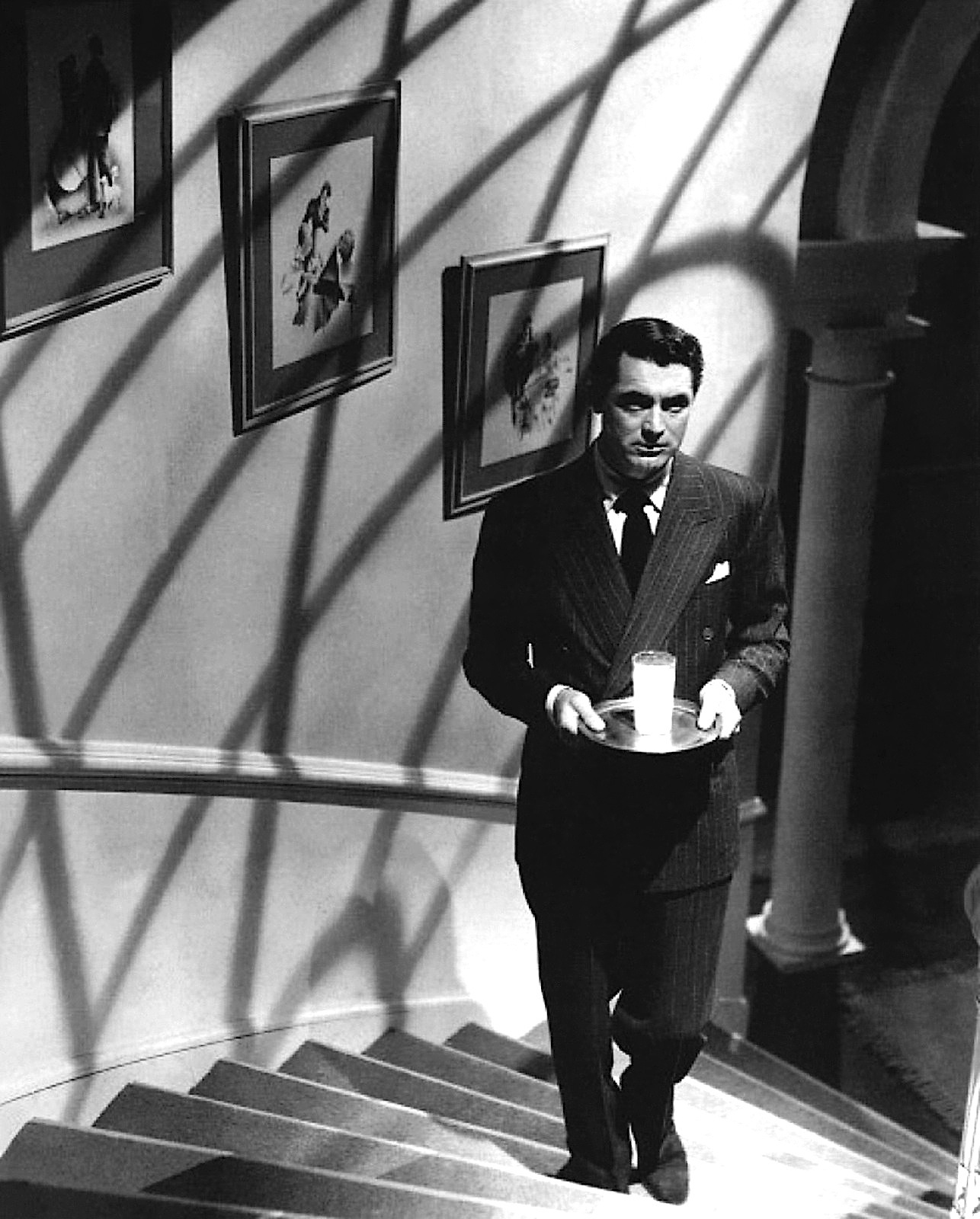
❖❖❖
IN THIS ISSUE
VIRGINIA'S COLONIAL WILLIAMSBURG
By John Mariani
NEW YORK CORNER
TBar STEAK AND LOUNGE
By John Mariani
NOTES FROM THE WINE CELLAR
THE WILLIAMSBURG WESSEX
HUNDRED WINERY
By John Mariani
❖❖❖
VIRGINIA'S COLONIAL WILLIAMSBURG
By John Mariani
Photos courtesy of Colonial Willamsburg
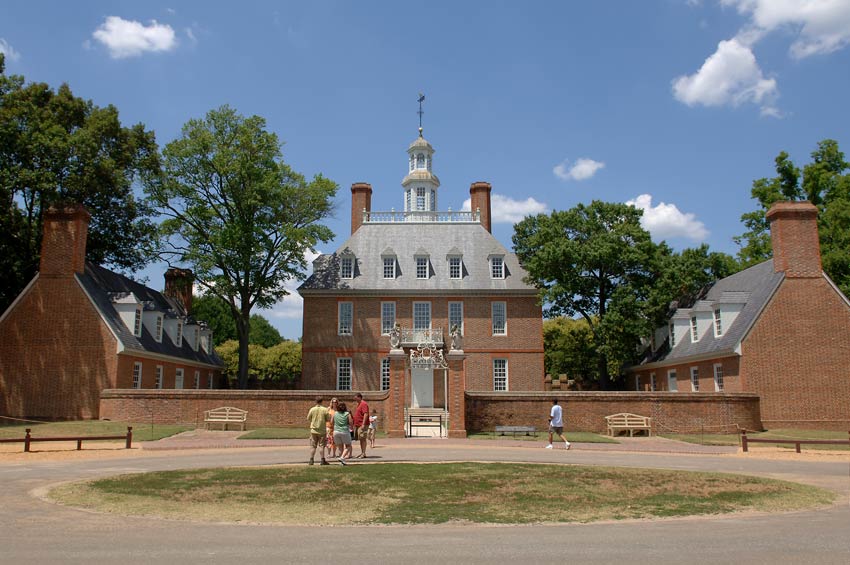
Colonial
Williamsburg is hardly alone among
America’s historic attractions in being a
reconstruction, rather than a rehab,
of an original site. Fraunces Tavern in New
York, Front Street and the Boot
Hill Museum in Dodge City, Old Sturbridge
Village in Massachusetts, and parts
of Old Salem in Winston-Salem are all
recreations on abandoned sites. Still,
some sticklers sniff that the
creators of Williamsburg somehow “Disney-fied”
American history by recreating
an impeccable colonial village complete with
hotels, restaurants, carriage
rides and cooking demos.
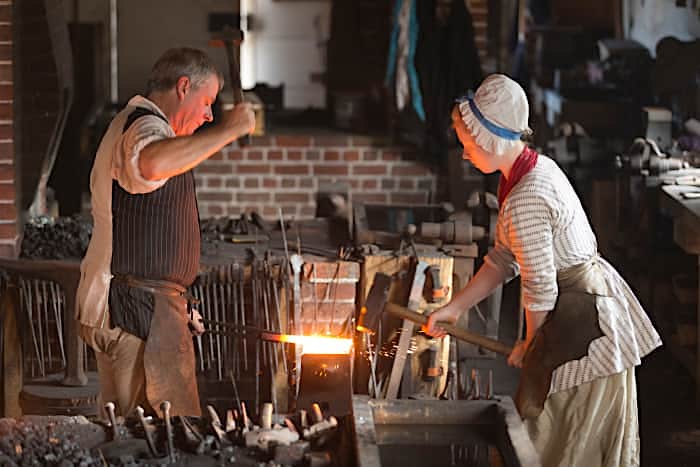 It is a
charge with no merit. For one thing
“CW” pre-dates Disneyland by three decades,
conceived in the late 1920s and
supported by the Association
for the Preservation
of Virginia Antiquities (now called Preservation
Virginia), the Colonial Dames
and the Daughters of the Confederacy, with the
principal benefactors including John D. Rockefeller Jr.,
and his wife, Abby Aldrich Rockefeller, whose idea was to make
CW a living museum, not a theme
park. (In fact, Walt Disney World’s The American
Adventure attraction in
Florida owes its inspiration to CW.)
It is a
charge with no merit. For one thing
“CW” pre-dates Disneyland by three decades,
conceived in the late 1920s and
supported by the Association
for the Preservation
of Virginia Antiquities (now called Preservation
Virginia), the Colonial Dames
and the Daughters of the Confederacy, with the
principal benefactors including John D. Rockefeller Jr.,
and his wife, Abby Aldrich Rockefeller, whose idea was to make
CW a living museum, not a theme
park. (In fact, Walt Disney World’s The American
Adventure attraction in
Florida owes its inspiration to CW.)
As part of the Historic Triangle of Virginia, which includes Jamestown and Yorktown (I will be reporting on these at another time), CW was designated a National Historic Landmark District in 1960. The village derives its name from King William III (as does the nearby College of William and Mary), but after nearly a century as the center of Virginia’s government, political and economic activity shifted to Richmond, so that by World War I the town was seriously derelict and most of its colonial buildings beyond repair.
When restoration came,
more than 700 post-18th century structures were
razed and 500 buildings were
reconstructed, including 88 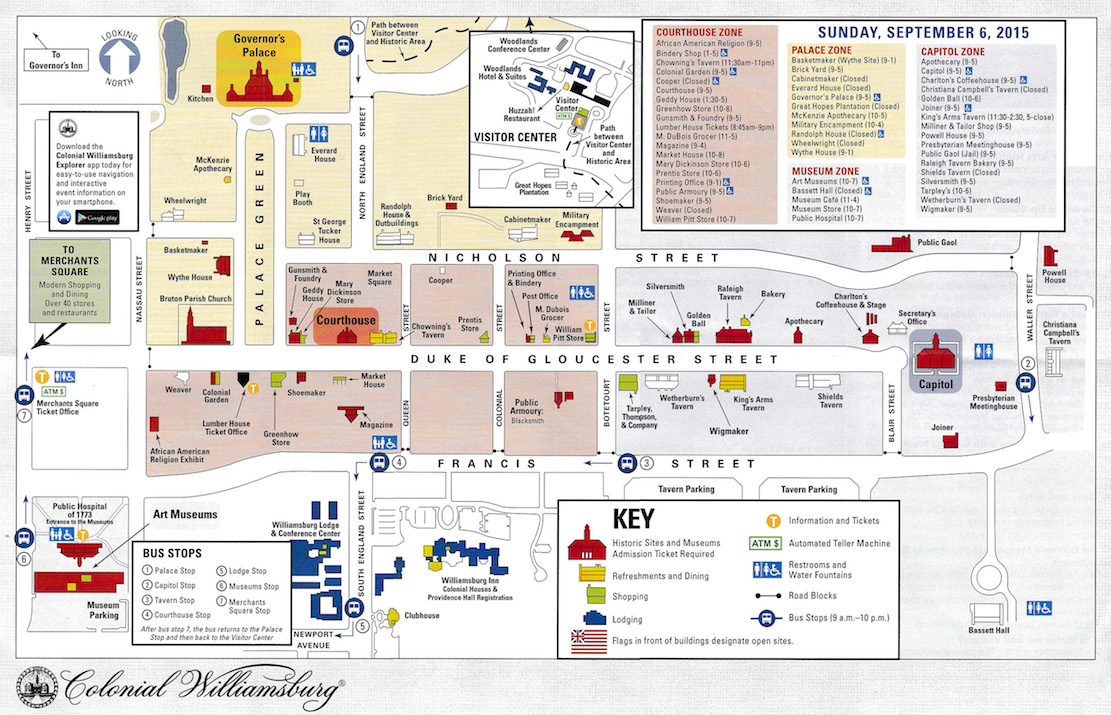 that were
salvageable. After World War II, CW
became one of the primary historic destinations
for Americans and foreigners,
hosting the first World Economic Conference in
1983.
that were
salvageable. After World War II, CW
became one of the primary historic destinations
for Americans and foreigners,
hosting the first World Economic Conference in
1983.
Further blunting the charge of artificiality was CW’s focus from the beginning on rigorous historical research, which today includes the Teaching Institute in Early American History, and constant interaction with school groups. A good deal of emphasis in recent years has been on black history via the “African-American Experience,” and there are numerous craft demonstrations in book binding, cabinet making, cooking and gardening.
The food has steadily been improved at the taverns—especially the King’s Arms (dating to 1772) and Christiana Campbell’s (supposedly one of George Washington’s favorites)—utilizing fruits and vegetables from local gardens and offering dishes typical of 18th century cooking, like peanut soup, a seafood fricassée and rum cream pie. The estate’s most expensive restaurant, the Rockefeller Room, in the luxurious Williamsburg Inn, has a more eclectic menu and has been undergoing some updating in service, though my meal indicated that the kitchen has a ways to go to be called contemporary fine dining.
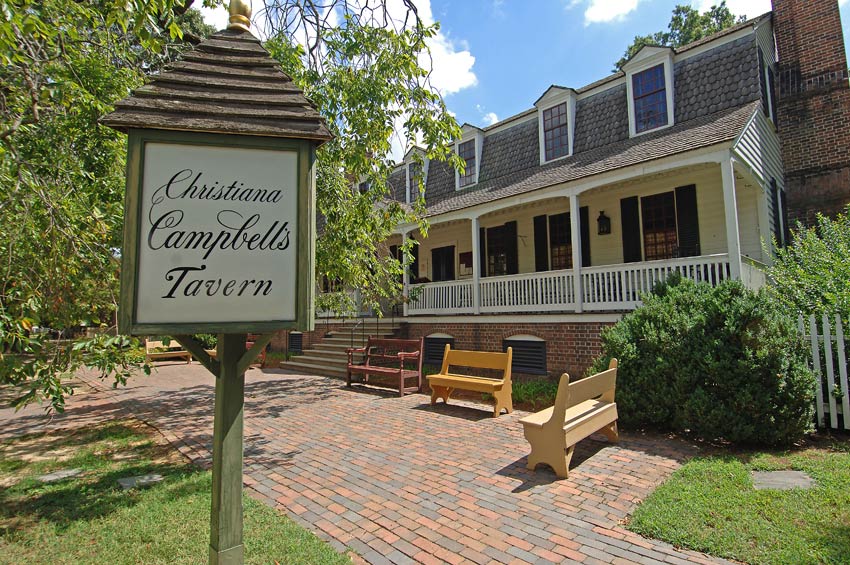 There are
several CW
ticket packages, with a single day ticket $40.99
for adults and $20.49 for
children, which includes shuttle service,
interpreter-led tours of the
Governor’s Palace, Capitol Building and all
Government Buildings, admission to
two art museums and seasonal tickets on carriage
rides. One
of the problems at CW is that it is
an open, un-gated village, meaning anyone without
a ticket can just stroll
through.
There are
several CW
ticket packages, with a single day ticket $40.99
for adults and $20.49 for
children, which includes shuttle service,
interpreter-led tours of the
Governor’s Palace, Capitol Building and all
Government Buildings, admission to
two art museums and seasonal tickets on carriage
rides. One
of the problems at CW is that it is
an open, un-gated village, meaning anyone without
a ticket can just stroll
through.
Tourist visits have been down since their peak in the 1980s, and operating deficits have plagued the foundation, causing a sell-off of some properties; in 2017 CW President and CEO Mitchell Reiss admitted there’d been too much dipping into the foundation’s endowment, which for the 2016 fiscal year reportedly dropped from $713 million to $663.6 million. With a $317.6 million debt, Reiss was forced to outsource management of the operation of the hotels, golf courses and several retail stores.
Key to CW’s continuance is
to convince tourists to spend more time in and
around the area, rather than the
one or two days typical of a family visit. Increasing that to three or
more days by exposing people to
nearby attractions, 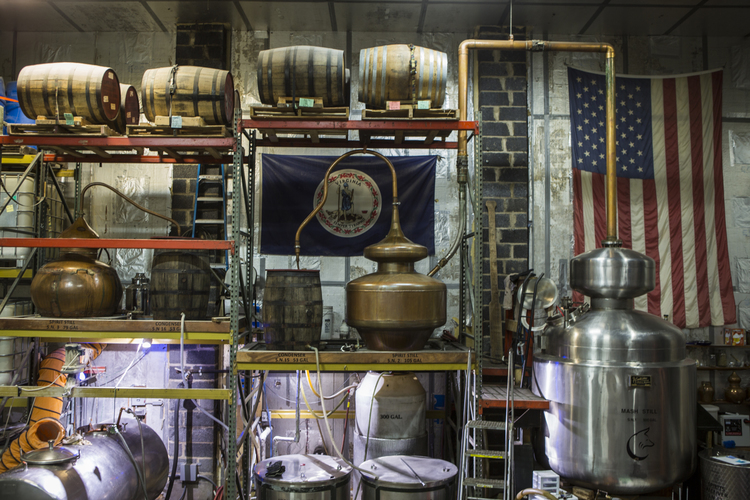 including Jamestown and
Yorktown, is critical.
including Jamestown and
Yorktown, is critical.
On a recent trip to the area, aside from enjoying the breadth and depth of CW itself, I was also able to visit the Copper Fox Distillery in Williamsburg, opened by Rick Wasmund (right) in 2016 at what was previously the Lord Paget Motel. He makes applewood-smoked single malt whiskey, a rye and gin, and the quickly expanding distillery is open to visitors.
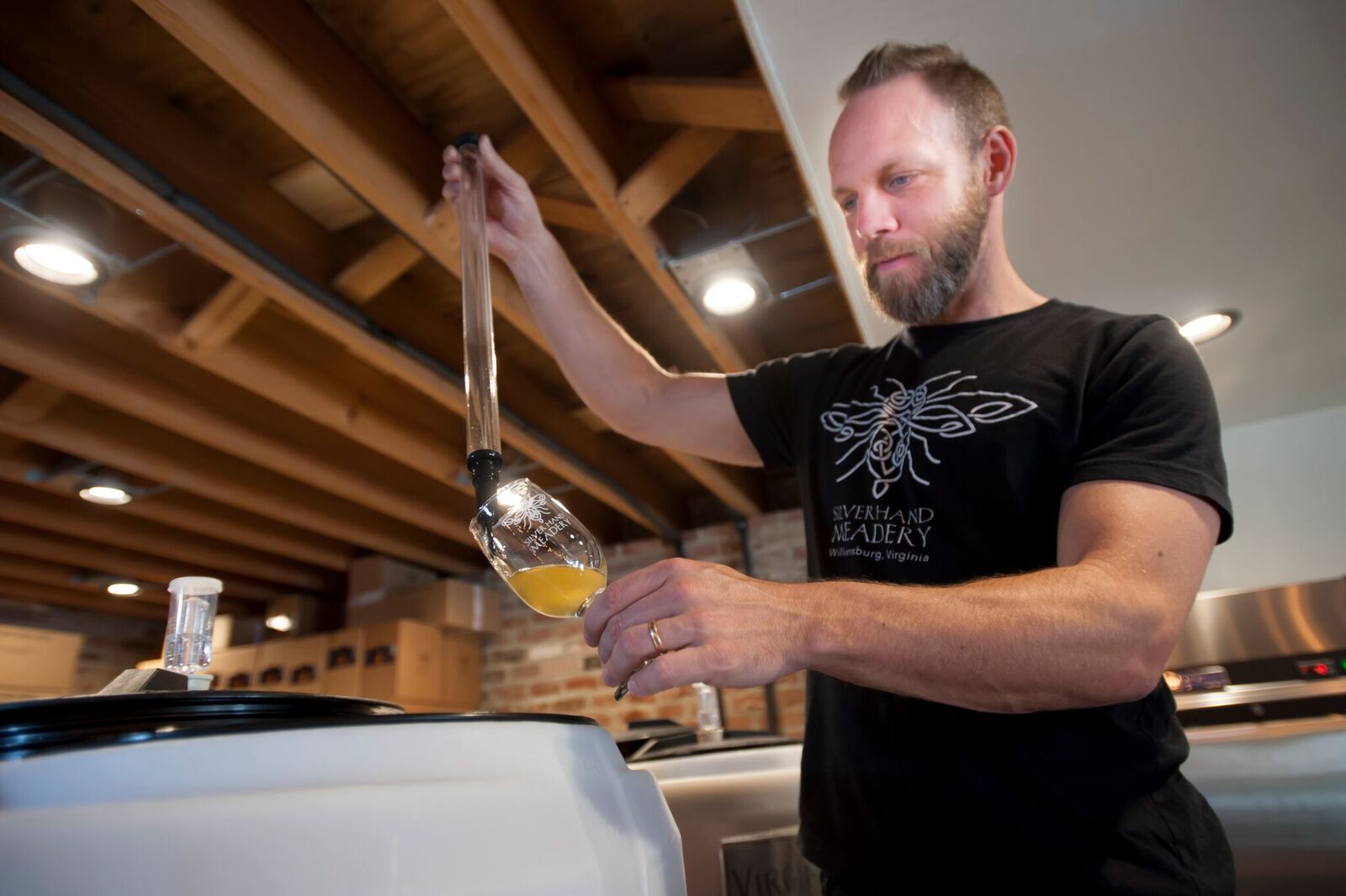 There
is also the Silver
Hand Meadery (left)
in a nondescript strip mall, which makes a number
of limited
quantity meads with beguiling names like Dream by
the Fire, All Blues and
Ginger Me Slowly. Tastings of the meads are free,
along with a tasting of six
honeys for
$6.
There
is also the Silver
Hand Meadery (left)
in a nondescript strip mall, which makes a number
of limited
quantity meads with beguiling names like Dream by
the Fire, All Blues and
Ginger Me Slowly. Tastings of the meads are free,
along with a tasting of six
honeys for
$6.
Then there is the Williamsburg Winery at Wessex Hundred, which, in addition to producing some very good wines, offers hotel packages, wine tastings, and delicious food at The Gabriel Archer Tavern, with a lunch that ranges from crab cakes and a pork sandwich to artisanal Virginia cheeses and charcuterie.

The Williamsburg area is rife with all levels of accommodations, and there are a dozen golf courses designed and landscaped by the likes of Pete Dye, Rees Jones, Robert Trent Jones Sr., Arnold Palmer, Curtis Strange, John LaFoy and Nicklaus Design Associates. One of the most highly regarded is Kingsmill Resort & Spa (above), with two golf courses—the River Course and the Plantation Course—and a range of AAA Four Diamond condos available. The resort is under new management that plans needed upgrades of the rooms and restaurant.
In a few weeks the full flourish of springtime will reveal the Virginia coast and countryside at its loveliest, just as it was three centuries ago when Williamsburg was truly a colony and the center of political clout in the South.
❖❖❖
By John Mariani
212- 772-0404
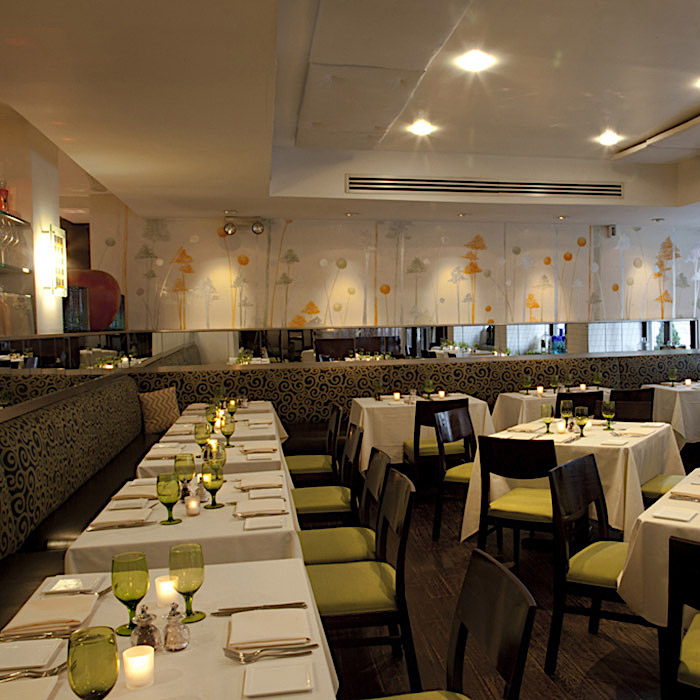
“Under the radar” is a term
usually reserved for people, places and things
that never attract much media attention but
that always have a full complement of faithful
fans. In
the case of the ten-year-old TBar, its
popularity has as much to do with its
redoubtable owner, Tony Fortuna (below),
as with its solid American cooking.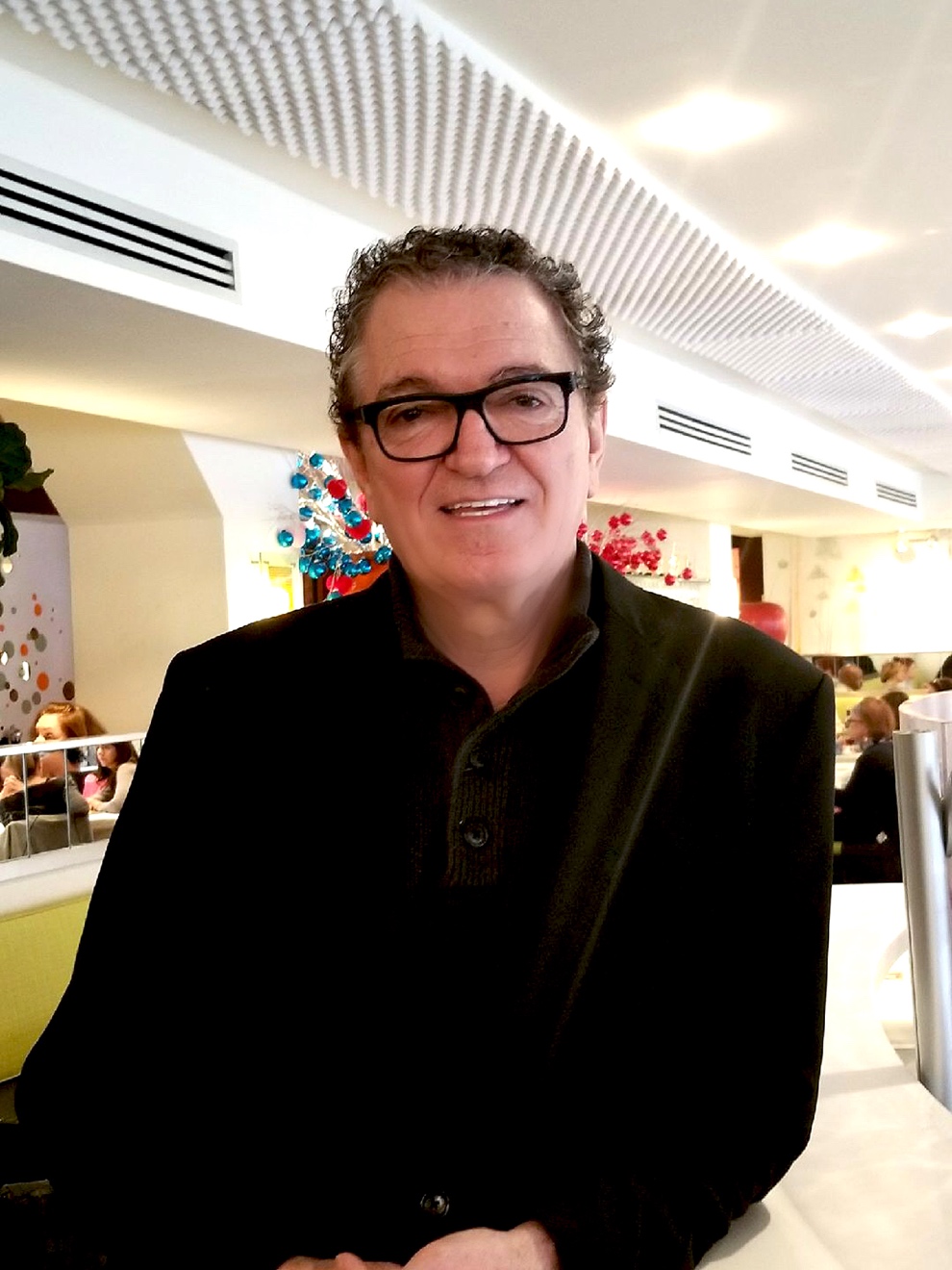
Tony is on the one hand very old school
in his demeanor and professionalism while on the
other he is sensitive to changing times and
tastes without ever glomming on to the merely
trendy.
Tbar’s menu, under its first and only
chef, Ben Zwicker, can easily be
characterized as modern American or contemporary
NYC, and the restaurant is clearly a
neighborhood place, in this case the Upper East
Side in the Seventies, so TBar draws a crowd not
otherwise in the mood for the slim pickings in
the area that begins with J.G. Melon and ends
with a slew of cookie-cutter Italian
restaurants.
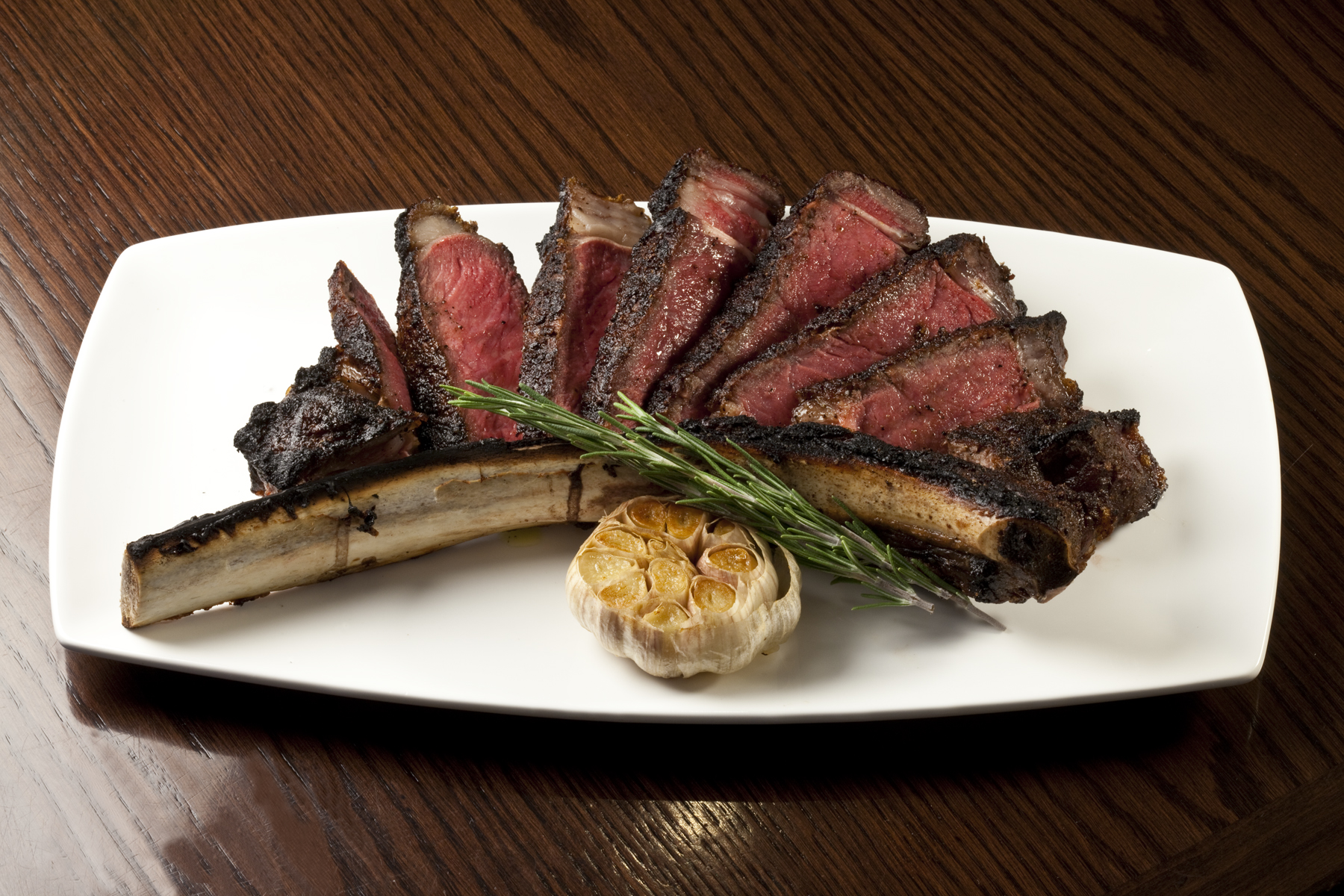 TBar
is
a smart-looking 100-seat dining room with
brightly lighted bar, fabric-covered banquettes,
soft overhead lighting, crisp tablecloths, votive
candles and a rear wall painting reminiscent of
Paul Klee.
When full, the room can get very loud up
until about 8:30, when the tenor of the place
loosens and the early crowd moves on. The women
dress well, the men, who once might have sported
blazers, now wear XXL polo shirts and Xtra
Comfort jeans.
TBar
is
a smart-looking 100-seat dining room with
brightly lighted bar, fabric-covered banquettes,
soft overhead lighting, crisp tablecloths, votive
candles and a rear wall painting reminiscent of
Paul Klee.
When full, the room can get very loud up
until about 8:30, when the tenor of the place
loosens and the early crowd moves on. The women
dress well, the men, who once might have sported
blazers, now wear XXL polo shirts and Xtra
Comfort jeans.
You will be greeted
by some of the loveliest and most capable
hostesses in NYC and cordially shown to your
table, where a waiter pops up within seconds to
give you your menu, cocktail and wine list. Tony
cruises the room, and just about everyone wants
to chat with him.
Although pizzas have become far too
common on non-Italian menus, TBar’s ultra-crispy
version makes for a good starter for four people
($17), as does a seared Spanish octopus with
potatoes, celery and olives ($20), tender, of
course, and nice and smoky. A foie gras and
chicken parfait ($15) takes on a piquant accent
from a cherry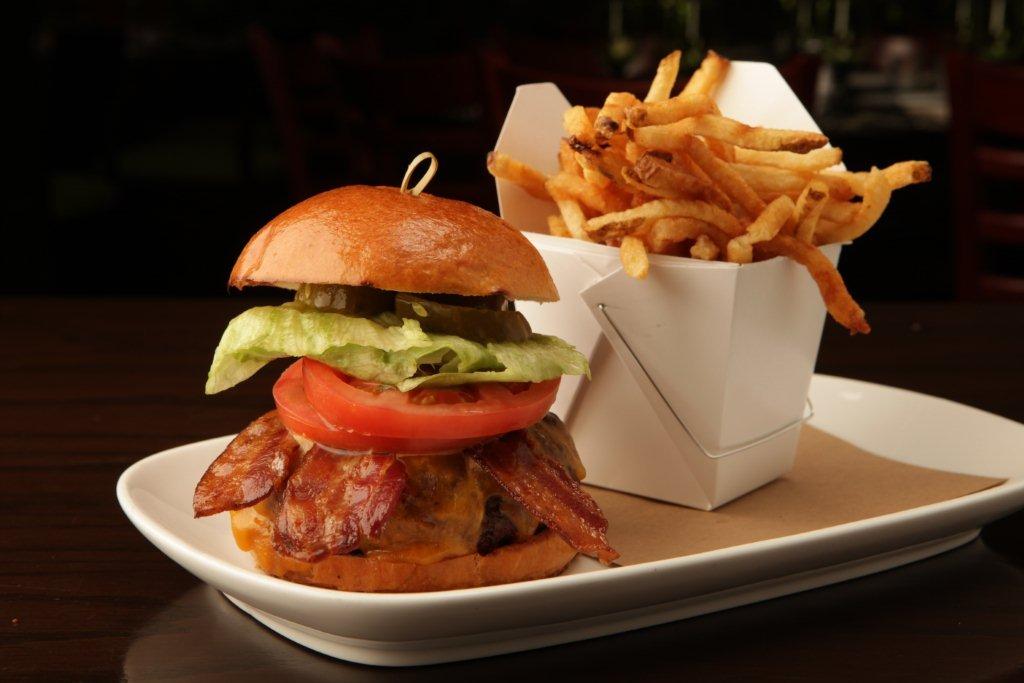 compote
to slather on a toasted baguette, and four fat
tiger shrimp come with a zesty cocktail sauce
and lemon ($22).
compote
to slather on a toasted baguette, and four fat
tiger shrimp come with a zesty cocktail sauce
and lemon ($22).
Among the main courses, if you’re in the
mood for roast chicken, you’ll be very happy
with TBar’s version, which is dependent first
and foremost on a good, flavorful bird.
A place like TBar has to serve a couple
of beef dishes, and in that category Fortuna and
Zwicker deserve high praise for the quality of
the meat they buy. The 14-ounce NY strip ($52)
was one of the best, most flavorful,
mineral-rich, fat and sweet examples I’ve had
outside of the city’s finest steakhouses, and
that same beef—Prime aged Black Angus--registers
just as high in the burger here ($26), a nicely
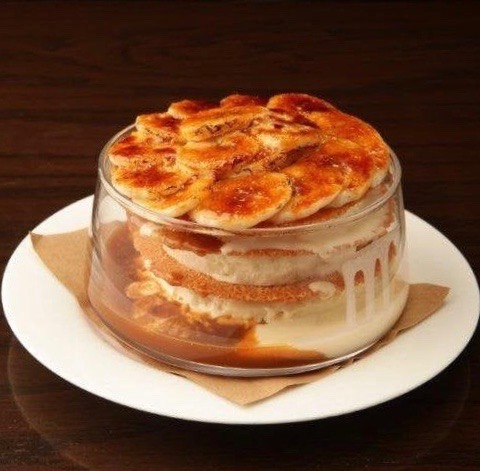 sized, lightly packed
patty with plenty of juice, layered with nothing
but lettuce, tomato and pickles, and sided with
a good portion of freshly cut French fries. It’s
a much better burger than the vaunted example at
J.G. Melon, though it’s a good deal more
expensive.
sized, lightly packed
patty with plenty of juice, layered with nothing
but lettuce, tomato and pickles, and sided with
a good portion of freshly cut French fries. It’s
a much better burger than the vaunted example at
J.G. Melon, though it’s a good deal more
expensive.
The desserts at TBar are remarkably
generous, all set in jars and layered with
first-rate ingredients that include a strawberry
shortcake sundae ($20), a banana cream
millefeuilles cookie tower ($20) and luscious
warm cookies ($10), all suitable for sharing at
the table.
TBar’s wine list is exemplary for a place
this size, with wines by the glass $11 to $22. I
wish Tony would put it on the website.
If TBar were
only a good, solid neighborhood American
restaurant it would thrive. I do
wish there was more change in the menu after a
decade, but what works really works well, And
the presence of Tony Fortuna in the mix makes it
one of a very special place on the Upper East
Side.
Open
for
lunch Monday through Friday, brunch Saturday
and Sunday, and every night for dinner.
❖❖❖
HUNDRED WINERY
By John Mariani
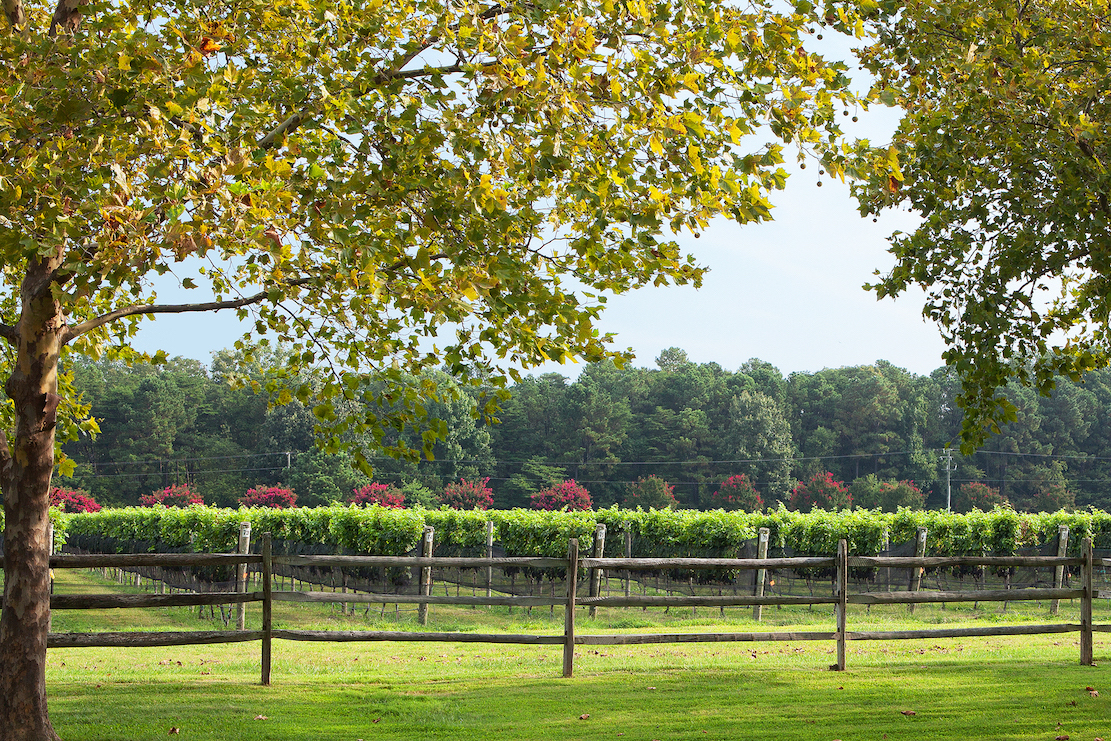
As with everything in Virginia, a little history is in order: Wessex Hundred is actually a 300-acre farm that is now home to the Williamsburg Winery, as well as to the Wedmore Place hotel, Café Provençal and the Gabriel Archer Tavern. The use of “Hundred” to name a property dates to the Colonial era to describe parcels of land sufficient to support a hundred families, regardless of actual acreage.
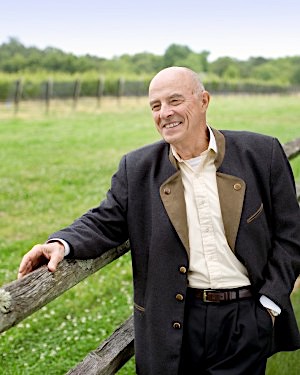 In
1606, the Virginia Company sent three ships
led by Bartholomew Gosnold to
attempt to settle a permanent English colony
in America.
Sailing up the James River and coming
upon the region now called Wessex, Gosnold’s
second in command, Gabriel Archer,
believed this protected tributary of the river
an ideal place for a settlement,
but the rest of the crew insisted on sailing
further, eventually setting down
in what became Jamestown on May 13, 1607.
In
1606, the Virginia Company sent three ships
led by Bartholomew Gosnold to
attempt to settle a permanent English colony
in America.
Sailing up the James River and coming
upon the region now called Wessex, Gosnold’s
second in command, Gabriel Archer,
believed this protected tributary of the river
an ideal place for a settlement,
but the rest of the crew insisted on sailing
further, eventually setting down
in what became Jamestown on May 13, 1607.
Flash
forward to 1983, when Belgian-born Patrick
Duffeler (left), a
former Philip
Morris executive, sought to leave the
corporate rat race to become a gentleman
farmer and to build his own winery, purchasing
300 acres in Williamsburg. In
2007 he opened a European-style country hotel,
Wedmore Place (right), on the property;
in 2013 his son, Patrick Duffeler II, was
appointed president  and
CEO of the company.
and
CEO of the company.
I met with the estate’s winemaker, Matthew Meyer, a Brit who studied at the University of California at Davis, earning a degree in Oenology and Viticulture with a minor in Business and Marketing. After graduation he worked with notable California wineries that included Grgich Hills Wine Cellars and Heitz Wine Cellars, arriving at Williamsburg in 2002 to become VP and Winemaker. He has since won an array of medals that in 2014 included his Adagio bottling winning the Virginia’s Governor’s Cup Award as the state’s highest rated wine.
In 2013 a Forbes article proposed that Virginia wine country was “poised to be the East Coast Napa,” and today the state has more than 300 wineries and has widely promoted its dozens of wine trails as tourist attractions. Williamsburg Winery is open year-round for tours and tastings ($10-$38 per person; $35 with lunch, $78 with dinner).
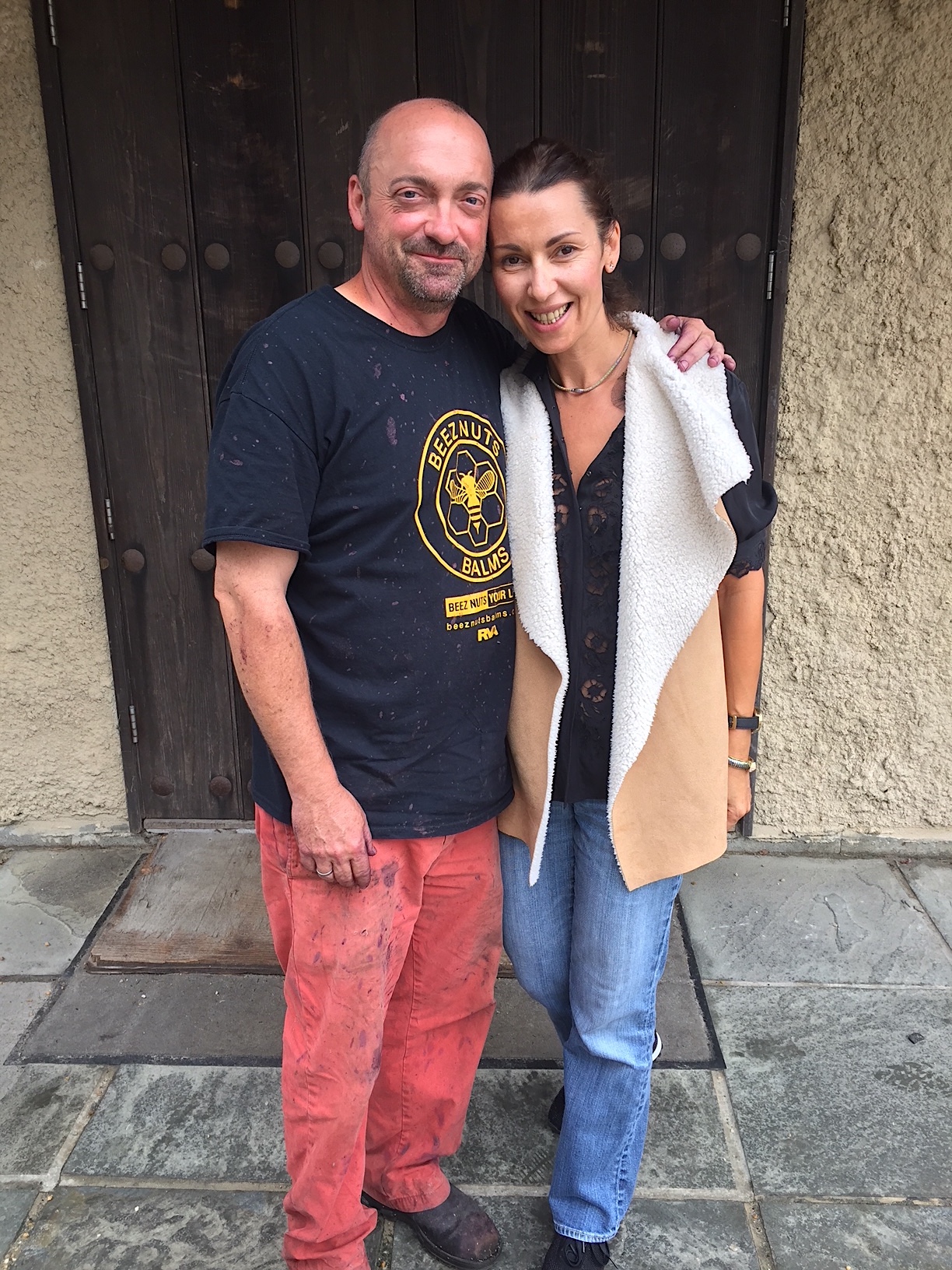 I
sampled several of Meyer’s wines over a
lunch with him and his charming wife,
Elena Barber (left), who is the estate’s
On-Site Trade Sales Manager, at the rustic
Gabriel Archer Tavern. (I’ll write more fully
about the restaurant in an
upcoming article) Just like the food, which
included some splendid cheese and
charcuterie, there was an honesty about the
wines. Though some were curious
varietal choices, none seemed manipulated to
appeal to a specific market
profile. Alcohol levels rarely hit above 14.5
percent, and there was good
balance in all the wines I sampled. Many of
the wines are in limited, seasonal
release and sell out at the winery.
I
sampled several of Meyer’s wines over a
lunch with him and his charming wife,
Elena Barber (left), who is the estate’s
On-Site Trade Sales Manager, at the rustic
Gabriel Archer Tavern. (I’ll write more fully
about the restaurant in an
upcoming article) Just like the food, which
included some splendid cheese and
charcuterie, there was an honesty about the
wines. Though some were curious
varietal choices, none seemed manipulated to
appeal to a specific market
profile. Alcohol levels rarely hit above 14.5
percent, and there was good
balance in all the wines I sampled. Many of
the wines are in limited, seasonal
release and sell out at the winery.
The
Petit Manseng grape is well known in southwest
France but rarely seen in
American vineyards, and it is best used to
make a tangy-sweet wine. Meyer’s
2016 vintage has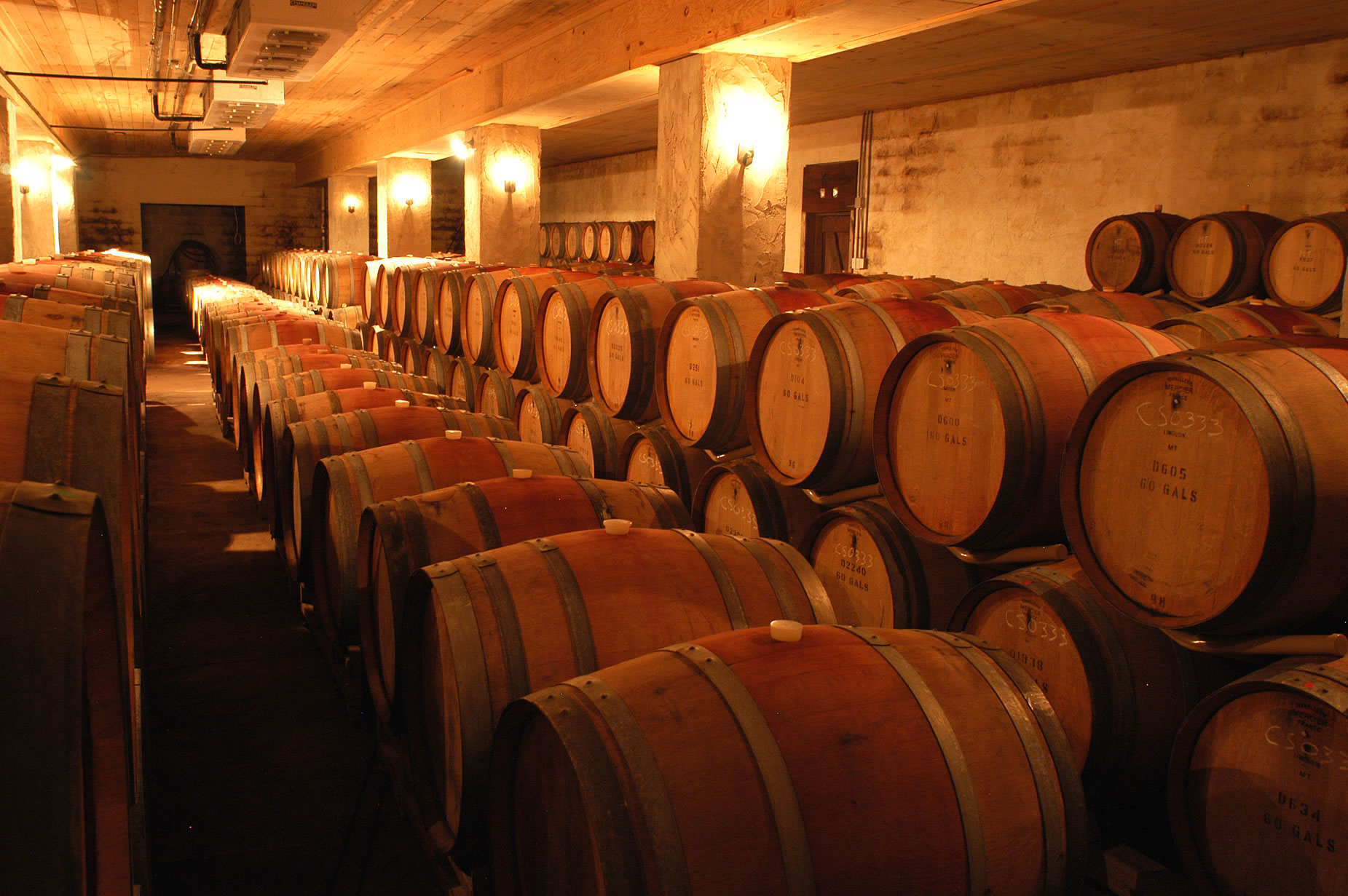 wonderful aromas of citrus and ripe autumn
fruit, and its
light sweetness was a true complement to the
cheeses and would be as easily
enjoyed as an aperitif this summer.
wonderful aromas of citrus and ripe autumn
fruit, and its
light sweetness was a true complement to the
cheeses and would be as easily
enjoyed as an aperitif this summer.
Viognier is a varietal that I find is not well understood by American winemakers, who too often produce an overly herbaceous style, but Meyer’s 2016 has far more finesse because of the acidity and for its spending a year in French oak. The winery’s website extols the wine as if “standing in a fresh field of wild flowers eating a lemon pie made from Granny (Granny’s always make the best pie),” whose hyperbole I’ll forgive because it seems to make sense when standing in these lovely Virginia vineyards.
The 2015 Gabriel Archer Reserve is a blend of 36% Cabernet Franc, 25% Merlot, 20% Cabernet Sauvignon, 12% Petit Verdot and 7% Malbec. (Meyer uses Argentinean Malbec root stocks.) But Meyer didn’t release a 2016 because he didn’t think he could make as good a wine as he’d wish from the vintage.
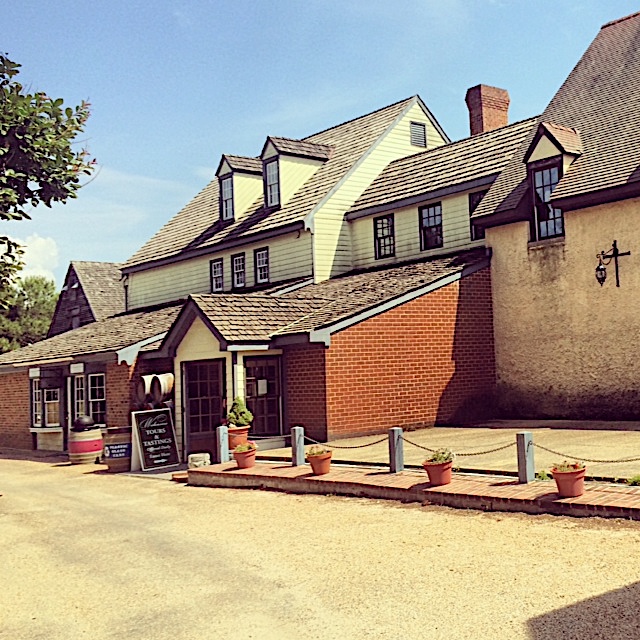 His
2015 Petit Verdot Reserve is a blend of 87%
Petit Verdot, 11% Malbec, and
2% Cabernet Franc, and it’s a big,
bold red whose tannins have yet to loosen but
which went nicely with the
sausages and charcuterie on the table.
His
2015 Petit Verdot Reserve is a blend of 87%
Petit Verdot, 11% Malbec, and
2% Cabernet Franc, and it’s a big,
bold red whose tannins have yet to loosen but
which went nicely with the
sausages and charcuterie on the table.
Adagio is one of Meyer’s proudest achievements, the 2015 a mix of 58% Petit Verdot, 15% Merlot, 15% Tannat, 12% Cabernet Franc. There’s something to the name, for, if wine can be compared to music, this Adagio evokes a slow movement whereby each of the flavors, the fruit, the acid, the texture and the satisfaction reveal themselves little by little, a wine to savor, sip by sip, peppery, earthy and with a fine long finish.
Some of Williamsburg’s wines are made from grapes grown entirely at the estate, others are sourced from Virginia vineyards elsewhere, and many are available only to the winery’s Club Members.
I mentioned to Meyer that he seems to make too many different wines, including spiced wines and a Vin Licoreux de Framboise blended with raspberries. But, he said, that’s the beauty of having a winery of Williamsburg’s size and private ownership. “I can experiment, go in new directions, and, if I don’t think a wine will be good enough, I don’t have to release it. And thanks to the tourism, the hotel and restaurants, people are very open to trying whatever it is we’re doing on a seasonal basis. They take their time here.”
❖❖❖
DULLEST--AND STRANGEST--OPENING LINE OF THE MONTH

“The biggest fruit native to
the continental U.S. is the pawpaw, sometimes called the
poor man’s banana.”—Hanna Raskin, “Pawpaw,” Charleston Post and
Gazette.
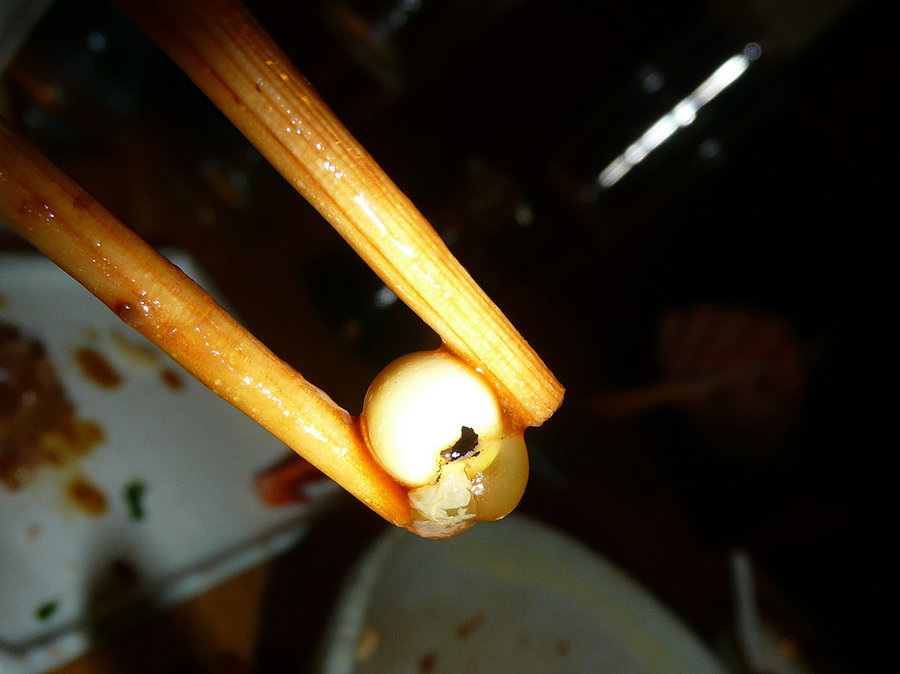
RESTAURANT
MOST LIKELY NOT
TO NEED DOGGIE
BAGS
Any of John Mariani's books below may be ordered from amazon.com.
 The Hound in Heaven
(21st Century Lion Books) is a novella, and
for anyone who loves dogs, Christmas, romance,
inspiration, even the supernatural, I hope you'll find
this to be a treasured favorite. The story
concerns how, after a New England teacher, his wife and
their two daughters adopt a stray puppy found in their
barn in northern Maine, their lives seem full of promise.
But when tragedy strikes, their wonderful dog Lazarus and
the spirit of Christmas are the only things that may bring
his master back from the edge of despair.
The Hound in Heaven
(21st Century Lion Books) is a novella, and
for anyone who loves dogs, Christmas, romance,
inspiration, even the supernatural, I hope you'll find
this to be a treasured favorite. The story
concerns how, after a New England teacher, his wife and
their two daughters adopt a stray puppy found in their
barn in northern Maine, their lives seem full of promise.
But when tragedy strikes, their wonderful dog Lazarus and
the spirit of Christmas are the only things that may bring
his master back from the edge of despair. WATCH THE VIDEO!
“What a huge surprise turn this story took! I was completely stunned! I truly enjoyed this book and its message.” – Actress Ali MacGraw
“He had me at Page One. The amount of heart, human insight, soul searching, and deft literary strength that John Mariani pours into this airtight novella is vertigo-inducing. Perhaps ‘wow’ would be the best comment.” – James Dalessandro, author of Bohemian Heart and 1906.
“John Mariani’s Hound in Heaven starts with a well-painted portrayal of an American family, along with the requisite dog. A surprise event flips the action of the novel and captures us for a voyage leading to a hopeful and heart-warming message. A page turning, one sitting read, it’s the perfect antidote for the winter and promotion of holiday celebration.” – Ann Pearlman, author of The Christmas Cookie Club and A Gift for my Sister.
“John Mariani’s concise, achingly beautiful novella pulls a literary rabbit out of a hat – a mash-up of the cosmic and the intimate, the tragic and the heart-warming – a Christmas tale for all ages, and all faiths. Read it to your children, read it to yourself… but read it. Early and often. Highly recommended.” – Jay Bonansinga, New York Times bestselling author of Pinkerton’s War, The Sinking of The Eastland, and The Walking Dead: The Road To Woodbury.
“Amazing things happen when you open your heart to an animal. The Hound in Heaven delivers a powerful story of healing that is forged in the spiritual relationship between a man and his best friend. The book brings a message of hope that can enrich our images of family, love, and loss.” – Dr. Barbara Royal, author of The Royal Treatment.
 |
The Encyclopedia of American Food and Drink by John F. Mariani (Bloomsbury USA, $35) Modesty forbids me to praise my own new book, but let me proudly say that it is an extensive revision of the 4th edition that appeared more than a decade ago, before locavores, molecular cuisine, modernist cuisine, the Food Network and so much more, now included. Word origins have been completely updated, as have per capita consumption and production stats. Most important, for the first time since publication in the 1980s, the book includes more than 100 biographies of Americans who have changed the way we cook, eat and drink -- from Fannie Farmer and Julia Child to Robert Mondavi and Thomas Keller. "This book is amazing! It has entries for everything from `abalone' to `zwieback,' plus more than 500 recipes for classic American dishes and drinks."--Devra First, The Boston Globe. "Much needed in any kitchen library."--Bon Appetit. |
"Eating Italian will never be the same after reading John Mariani's entertaining and savory gastronomical history of the cuisine of Italy and how it won over appetites worldwide. . . . This book is such a tasteful narrative that it will literally make you hungry for Italian food and arouse your appetite for gastronomical history."--Don Oldenburg, USA Today. "Italian
restaurants--some good, some glitzy--far
outnumber their French rivals. Many of
these establishments are zestfully described
in How Italian Food Conquered the World, an
entertaining and fact-filled chronicle by
food-and-wine correspondent John F.
Mariani."--Aram Bakshian Jr., Wall Street
Journal.
"Equal parts
history, sociology, gastronomy, and just
plain fun, How Italian Food Conquered the
World tells the captivating and delicious
story of the (let's face it) everybody's
favorite cuisine with clarity, verve and
more than one surprise."--Colman Andrews,
editorial director of The Daily
Meal.com. "A fantastic and fascinating
read, covering everything from the influence
of Venice's spice trade to the impact of
Italian immigrants in America and the
evolution of alta cucina. This book will
serve as a terrific resource to anyone
interested in the real story of Italian
food."--Mary Ann Esposito, host of PBS-TV's
Ciao
Italia. "John Mariani has written the
definitive history of how Italians won their
way into our hearts, minds, and
stomachs. It's a story of pleasure over
pomp and taste over technique."--Danny Meyer,
owner of NYC restaurants Union Square
Cafe, The Modern, and Maialino.
|
 |
 |
 |
 |
 |
 |
 |
 |
 Everett Potter's Travel Report:
Everett Potter's Travel Report: 
 Eating Las Vegas
JOHN CURTAS has been covering the Las Vegas
food and restaurant scene since 1995. He is
the co-author of EATING LAS VEGAS – The 50
Essential Restaurants (as well as
the author of the Eating Las Vegas web site: www.eatinglasvegas.
He can also be seen every Friday morning as
the “resident foodie” for Wake Up With the
Wagners on KSNV TV (NBC) Channel 3 in
Las Vegas.
Eating Las Vegas
JOHN CURTAS has been covering the Las Vegas
food and restaurant scene since 1995. He is
the co-author of EATING LAS VEGAS – The 50
Essential Restaurants (as well as
the author of the Eating Las Vegas web site: www.eatinglasvegas.
He can also be seen every Friday morning as
the “resident foodie” for Wake Up With the
Wagners on KSNV TV (NBC) Channel 3 in
Las Vegas.

MARIANI'S VIRTUAL GOURMET
NEWSLETTER is published weekly. Editor/Publisher: John
Mariani.
Editor: Walter Bagley. Contributing Writers: Christopher Mariani,
Robert Mariani, Misha Mariani, John A. Curtas, Geoff Kalish, Mort
Hochstein, and
Brian Freedman. Contributing Photographer: Galina
Dargery. Technical Advisor: Gerry McLoughlin.
If you wish to subscribe to this
newsletter, please click here: http://www.johnmariani.com/subscribe/index.html
© copyright John Mariani 2017

